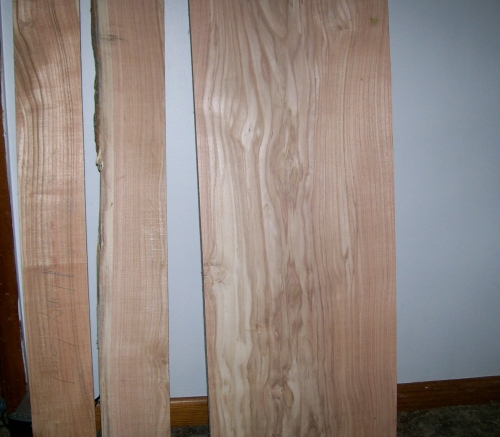Valuing Unusual Boards
Arriving at a price for a one-of-a-kind large piece of wood is a very subjective process. December 6, 2009
Question
The piece below is 1 1/8"x16"x6' It is kiln-dried and surfaced on one face. I could only get a hold of one place to price check with. They were getting $7.60/bft S2S with one straight edge. I just wanted to see how you guys would figure its value. If I remember correctly there price was for 6-8 inch wide material.

Click here for higher quality, full size image
Forum Responses
(Sawing and Drying Forum)
From contributor O:
What is it?
From the original questioner:
Itís honey locust - sorry about that.
From contributor S:
Things are worth what someone will pay for it. Just because some retailer is charging $7.50 a bd/ft for lumber doesn't mean itís worth that, unless you can convince a customer to give you that much for it. So it all comes down to this: how much is it "worth" to you? Would you rather have that plank or would you rather have a $20 bill? Maybe $50 would make you part with it? Or maybe you are willing put it in your inventory at $7.50 a bd/ft and wait 'till the right buyer comes along? How many people really want honey locust anyway?
From contributor A:
My thinking on the matter is that is a rare board. Since you just have one and I have none it is worth even more. I sold one board a while back for $350 and it was the only board I have ever had like it or most likely will again. So $7 or $8 dollars a bdft would not seem unreasonable. So $60 or so dollars for that board would not be too far out there. Now you may need some other sizes to go with it to make a table or something but it is a pretty board. I think I would start at about $75 as it is easier to come down then go up.
From the original questioner:
It was a monster of a tree for honey locust in this area. There are actually four or five more the same width an length, and thatís not including the 2.5" thick bar top that came out of the center of it with two natural edges. I wish I still had it. I realize that its value is what the market will stand, so I guess my question should have been - does anyone use a formula for calculating what those extra inches of abnormal width add. In the end I suppose itís like contributor S said, it would just be nice to have a better reason for the customer than, "well itís pretty and I like it, so thatís why itís double the price/bft of the 1x8ís sitting next to it!"
From contributor V:
It's worth what someone will pay for it. I sawed about 600 board feet for a customer about a year ago in honey locust, and about 1/3 of the job was 14"-18" wide. I charged $3.00 per board foot in the green, and that was fair because I have great access to this wood standing in tree form ready for custom orders. If you only have a board or two and you are trying to catch retail prices, you will not find this easy to accomplish!
I would give the board a dramatic price drop from the start because it is surfaced one face. This is a bad move. Proper millwork considers the fact that wood dries evenly, and therefore, equal amounts of wood should be removed from each face so tension is removed as equally as you remove the material. Looking at the wood from a scientific standpoint, it is always going to be a little wetter in the core than the surface, so by surfacing it on one face you are working towards a wetter core, and not relieving the opposite face, therefore creating tension where tension should not exist. If you take a perfectly dry board, and let one side soak in water while the other remains dry, the wet side will expand, and the dry side will compress creating warp.
I also do not agree with the bar top out of the middle slab. This may be possible with forgiving woods like walnut on some occasions, but honey locust likes to warp and check so this is a bad idea. It is basically creating two stable surfaces for quartersawn faces, combined with a core cut center, that wants to move the quartersawn surfaces like wings flapping on a bird. Thatís a bad idea unless it just happened to dry in a kiln properly without and checking to indicate tension at the least.
There really are no calculators for determining values on rare woods. The companies that deal with rare woods always figure their prices based on a few different aspects. First of all how replaceable is the wood? How hard was it to obtain? How common is the wood? How hard was it to saw? How much heavy equipment was involved, and how to properly make each machines involvement pay for its usage? How much of this wood do you have, and what are your competitorsí prices? These are the questions that small business owners ask themselves daily, and good business owners ask themselves in subconscious thinking.
